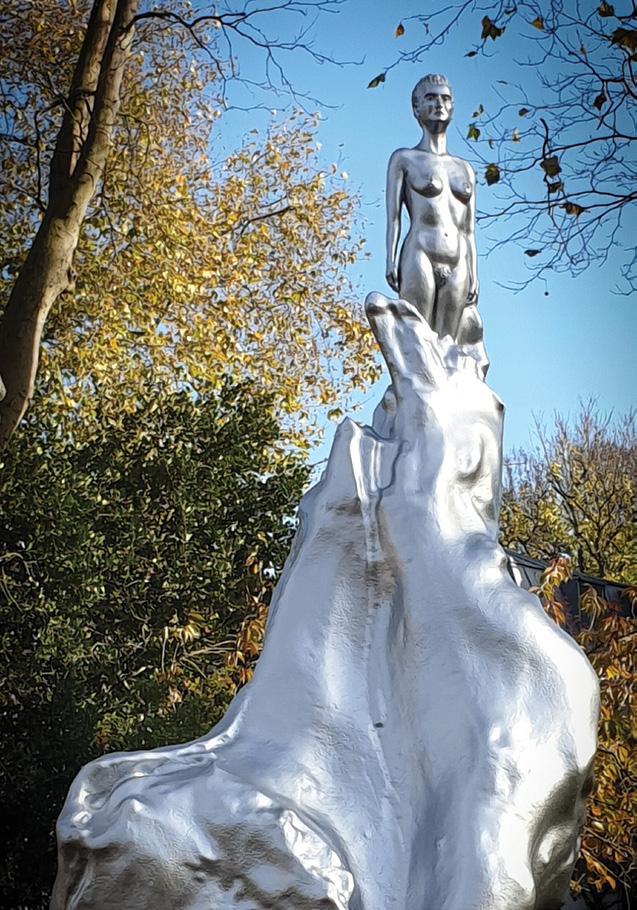
32 minute read
STAND EASY
STAND EASY An exhibition of new work by George Coutouvidis Prince Albert Gallery 16 December - 17 January 2020
In his second solo exhibition at the Prince Albert Gallery, George Coutouvidis reveals a body of work that coheres like kin, like an extended family.
Advertisement
At Dirst glance, there appear to be fewer colonial subjects and scenes of war. We Dind portraits of royals ‘posing’ for the artist, we are introduced to individual sitters who invite us to engage; and we are transported to the canals of Venice. Carl Becker in his article in Art Times Dec/Jan 19 wrote “Survival, not the reality- show kind, but as in the trenches of World War 1, is a recurring theme. Fascinated by calamity and human folly, the artist’s mindset is more Goya, less the cool detachment of contemporary art.”
Familiar characters - the artists’s subjects – emerge from earlier paintings. “The End of MM” and “Here’s looking at You” are drawn from popular culture. The art history references (Goya, Delacroix, Titian, Gainsborough and Vermeer) are there, yet the tone is informal, more ‘cool’, more everyday.
Coutouvidis’ source material intrigues the viewer: do the visual media that pervade our living tell us who we are? His response is that he has no idea whether his content is relevant today.
In his remaking, Coutouvidis’ sources take shape as simpler forms. This body of work signals a stylistic shift: a ‘shorthand’ orders the painted surface. Outlines are sketched in almost throw-away brush marks.
“Pugs and Owners” with three sedate sitters and their dogs is painted in shorthand, and situated in colour. The violence in “The Lion Hunt” is rendered in short broken strokes. And in “Wow” the loosely brush-stroked triumphal arch steals attention away from the line-up of beauty queens.
MM, unframed oil on canvas, 580mm x 780mm

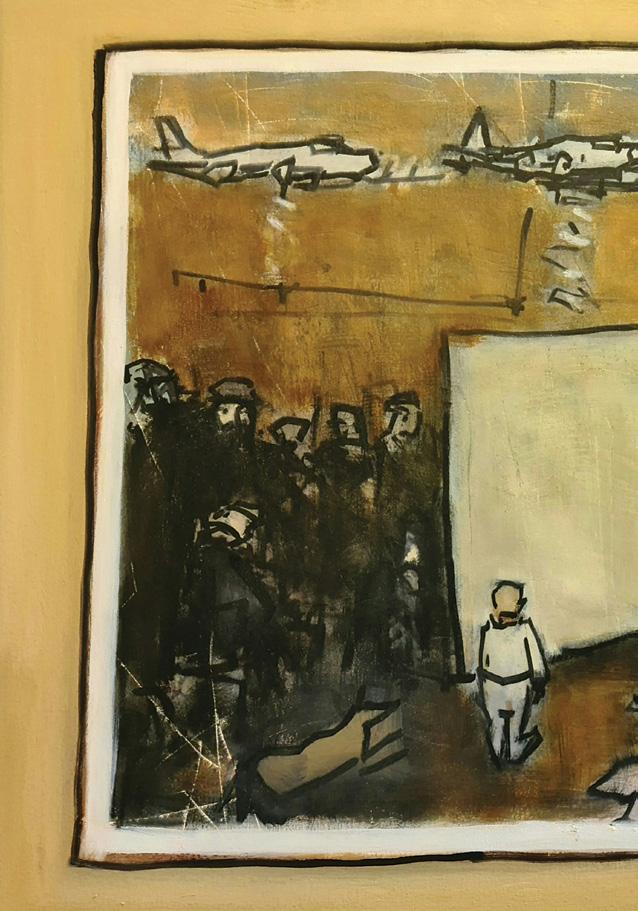

Lion Hunt, unframed oil on canvas, 580mm x 700mm. Previous Page: Last stand, unframed oil on canvas, 660mm x 880mm
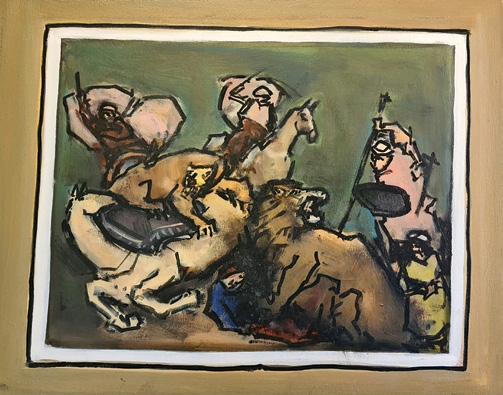
The artist builds up textured grounds with colour: compare “Pelican” with its ethereal colour and the darker, layered “Lion Hunt”. His magical pictorial spaces are off-set by the economical use of strong colours , as in “Royal Family” with the sullen guy in the gorgeous pink suit.
The artist uses modulated grey glazes for luminous skies and watery foregrounds. In the Venetian paintings, the painted water can be either disturbed by splashes of paint, or deep and reDlective as in “The Inevitable”.
Throughout this collection it’s as if the subjects have found their way into the frame and are at home there. Coutouvidis says that he enjoys working within the painted frame “...it doesn’t go on and on. This is it. The frame contains everything.” In his article Carl Becker referred to how the artist will “erase and re-work a painting and stated “That ‘just –right-ness’ is about meaning as much as technique”. The painting, “The End of MM’” which shows Mickey lying supine in an open limo, was erased and reworked until it was “just right”. And the peachy foreground in “Las Meninas ‘Herself’“ steadies the princess holding centre-stage perfectly.
Asked about his creative process Coutouvidis added “It’s a wonderful thing to be in a painting – like millions of us artists around the world - and be happy about it.”
“Stand Easy” on exhibi2on at the Prince Albert Gallery from 16 December un2l 17 January 2020
THE DON QUIXOTE PORTFOLIO On show at Oliewenhuis Art Museum
www.nasmus.co.za
The stone lithography press at Atelier le Grand Village. Opposite Page: Artists working in the studio at Atelier le Grand Village (clockwise from top left: Leon de Bliquy, Bambo Sibiya, Christiaan Diedericks, Pauline Gutter, Jan Vermeiren)
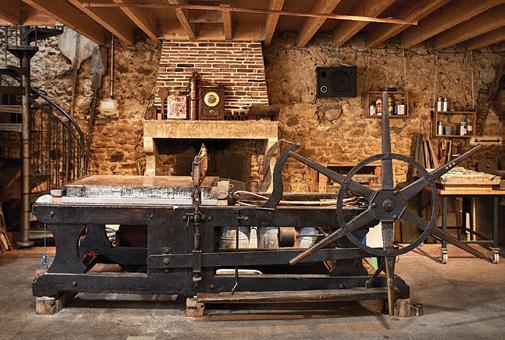
Oliewenhuis Art Museum is pleased to announce that a recent donation, The Don Quixote Portfolio, will be on exhibition from 10 December 2020 to 21 February 2021. The portfolio was inspired by Spanish writer Miguel de Cervantes’ novel ‘Don Quixote’ published in two parts - part 1 in 1605 and part 2 in 1615. Illustrating selected quotations from Cervantes’ novel, which appear as printed sheets in the portfolio, it features the work of 16 artists and was printed at Atelier le Grand Village.
Atelier le Grand Village is a lithography studio located in the hamlet ‘le Grand Village’ in the Charente-Limousine area, in the south-west of France. The founder, Francis van der Riet, was born and grew up in the Eastern Highlands of Zimbabwe. He studied in Cape Town and has lived in France since 1988. The aim of the studio is to revive the art of lithography by inviting artists in residence from around the world.
Well known South African artists, namely, Diane Victor, Bambo Sibiya, Willem Boshoff, Jan Vermeiren, Leon de Bliquy, Christiaan Diedericks, and Pauline Gutter have printed at Atelier le Grand Village and contributed to the portfolio. Other South African artists that printed at the studio includes Mongezi Ncaphayi, Banele Khoza, Hanneke Benade and Themba Khumalo. The following international artists contributed to the portfolio: Michael Barnes, Sasha Bitzer, Corrine Forget, AnneCatherine Charbonnier, NINA Kovacheva, Patrice Lefèvre, Valentin Stefanoff, Suzanne Touvay and Francis van der Riet.

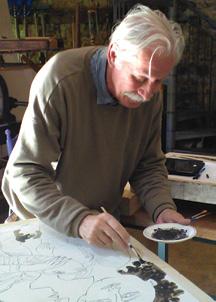

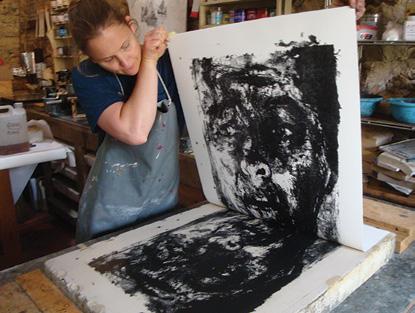
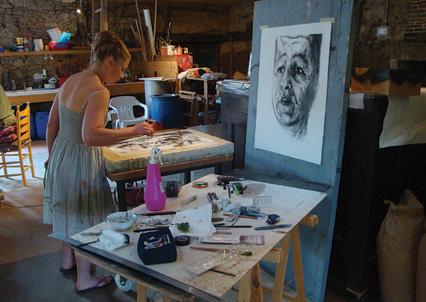

Bambo Sibiya
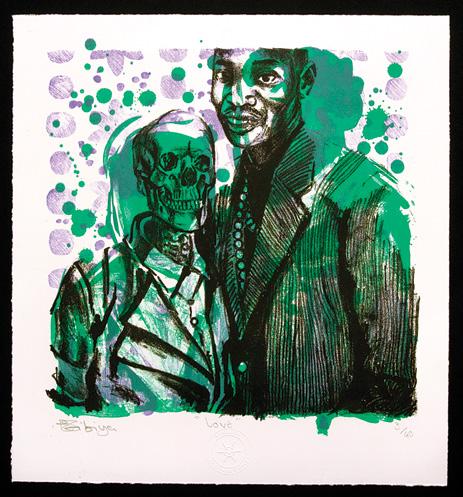
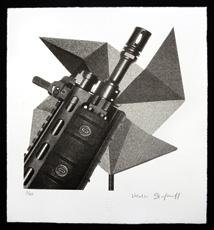

Christiaan Diedericks
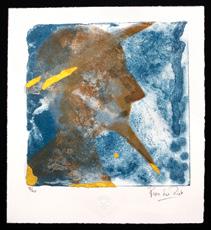
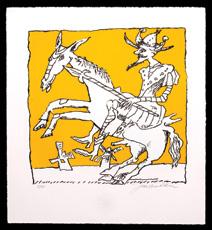
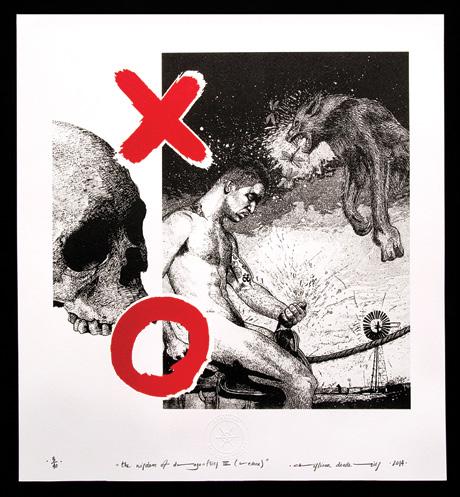
NINA Kovacheva Suzanne Touvay

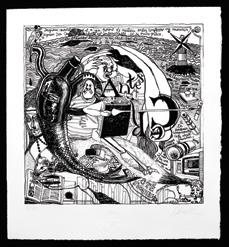
The Quixote / Quichotte Portfolio was one of the first group projects of the studio. The idea was for a collection of artists that had previous residencies at the studio, to contribute to this portfolio, with the aim of showcasing the richness of lithography as a printing technique. It also shows how artists personalise the technique, resulting in a rich variety of styles. The portfolio of 16 artworks, 39cm (h) x 36 cm (w) took around 5 years to complete.
From the start it was agreed with the artists that each would receive one edition of the portfolio and that the studio would donate editions to institutions in the countries where the artists came from. As the majority of the artists are South African, it seemed fair and appropriate to donate an edition to two institutions in South Africa. Atelier le Grand Village have already donated one edition to the Iziko South African National Gallery. Willem Boshoff suggested that the studio approach Oliewenhuis Art Museum, and the Advisory Committee gladly approved an edition to be accepted into the Permanent Collection. It was a wonderful opportunity to expand the collection and is in line with Oliewenhuis Art Museum’s objectives for the collection which include; ‘To collect, document, conserve and research works of art acquired through purchase, commission, bequest and donation.’ Editions were also donated to the following collections: Bibliothèque Nationale de France, Victoria and Albert Museum, London and the Albertina collection, Vienna.
Oliewenhuis Art Museum is located at 16 Harry Smith Street, Bloemfontein. The visiting hours during Level 1 is from Monday to Friday between 09:00 and 15:00, Saturdays between 10:00 and 15:00 and closed on Sundays. Entrance is free and secure parking is available for visitors and for buses. A ramp at the entrance of the main entrance provides access for wheel chairs, while a lift provides access to the Permanent Collection display areas on the first floor.
For more information on Oliewenhuis Art Museum please contact the Museum at 051 011 0525 (ext 200) or oliewen@nasmus.co.za. Stay up to date by following Oliewenhuis Art Museum on Facebook, Instagram and Twitter for all upcoming exhibitions and events.
For more information on Atelier le Grand Village please visit www.legrandvillage.net and follow all the happenings at the studio on Instagram (@atelierlegrandvillage).
An exhibition of artist’s proofs
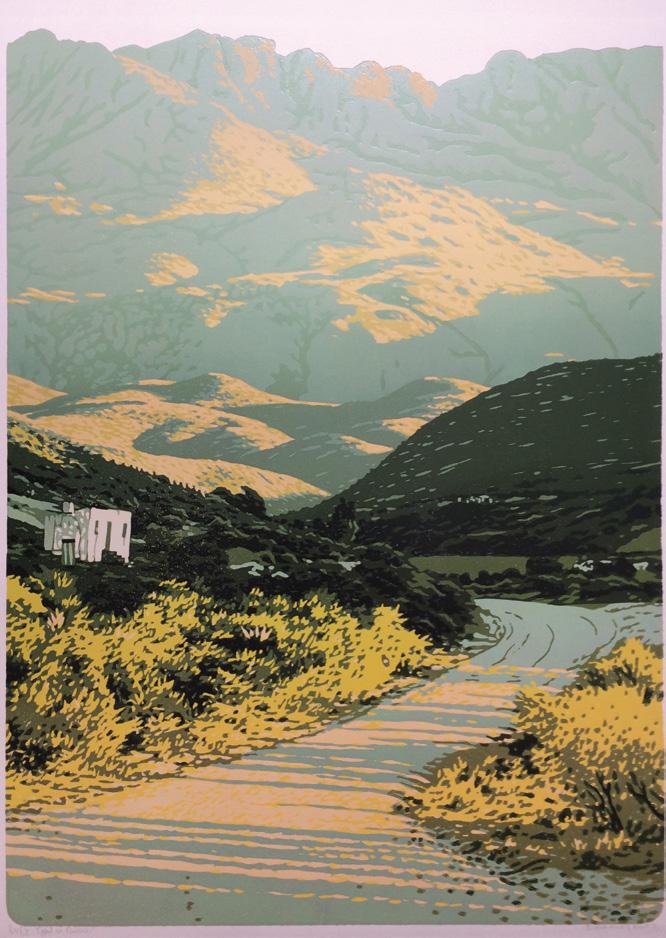
FAREWELL / HAMBA KAHLE, 2020 IS Art Gallery
By Hendrik Theron www.is-art-gallery.com
Above: Vernon Swart, Tankwaperd. Opposite Page: Johann Slee, Laat Sonneblomme
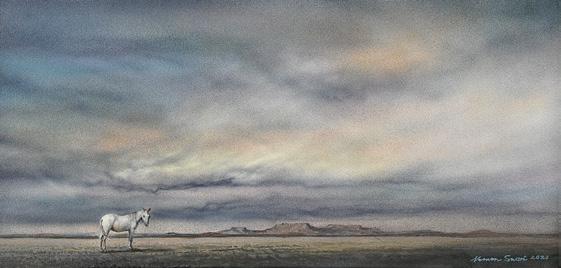
As the year 2020 – perhaps in its revelation, and perhaps in its reverie – needs no introduction, similarly, there also needs no further support for our staunch desire to bid it a swift, unceremonious farewell.
With vigorous, searing brush-stokes, not unlike an artist vehemently re-using a battered old canvass, forcefully impressing upon it a “new” vision of what it ought to be, this year has been a tangible re-imagination of our world, and one that will leave a deep impression. Whatever this year may have meant to us – the good, the bad, and the ugly – one thing stands as trite, it is now, and will forever be, history. We find ourselves then on the cusp of turning over a new leaf, of starting anew and closing off a chapter we all otherwise wish we could have skipped.
That being said, we now venture into the unknown crevasses of the future. Humanity is inherently frightened of what lies ahead – in the darkness, beyond that shadow cast on the ground. Having braved the rigours of this year, however, and perhaps out of nothing more than hopeless optimism, we remain resolute and ready for any eventuality. As South Africans, we have a proven tenacity and spirit that is unmatched by any other nation. Time and time again, South Africans are knocked down and keep getting up, each time building stronger and stronger foundations. This resilience, while flowing like a golden thread through the many folds, creases, and corners that make up our celebrated rainbow-nation, also weaves its way into our art.
In Xhosa, “farewell” is expressed as “hamba kahle”, which translates literally to “go well” – this then, is an articulation of our natural inclination, irrespective of creed or culture, to follow-through a greeting with ceremoniously wishing upon one another good fortune and prosperity for what lies ahead. The phrase then resonates on an inherently South African level – “go”, referring to the inevitability of having to move on, whereas “well” refers to the resilient optimism which South Africans carry with them though any journey.

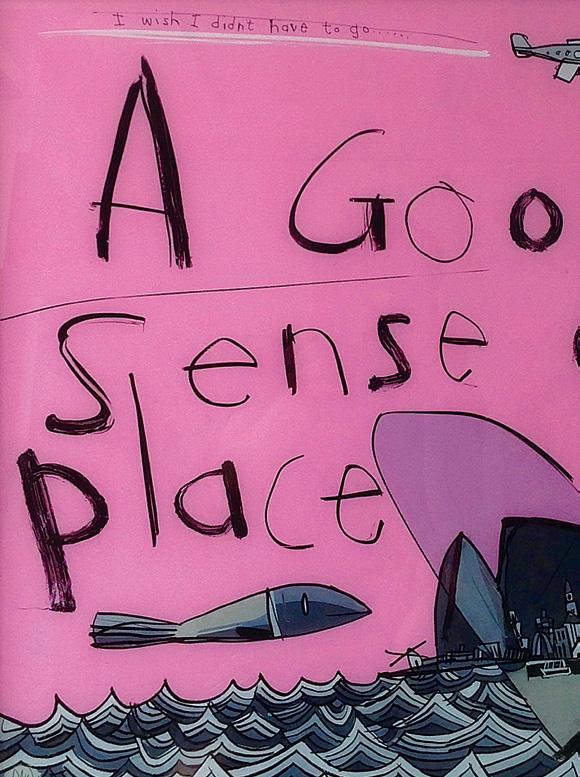

Cornelia Stoop, Jacket Casual

Ilse Nieman, The Experience of Existence

In true South African character, not only has our art braved the metaphorical storm, it has done so resoundingly undeterred and has moved from strength to venerable strength, claiming its stake between the pages of history. This, if nothing else, is deserving of celebration.
IS Art in its annual year-end group exhibition titled, Farewell / Hamba Kahle has brought together a dynamic and colourful selection of artists that have come to represent not only IS Art and its offerings over the years, but the very best that South African art and our rainbow-nation has to offer. IS Art presents these works from Strijdom van der Merwe, Wilma Cruise, Sharlé Matthews, Cornelia Stoop, Judy Woodbourne, Jacqueline CreweBrown, Helen Vaughan and Sarel Petrus, to name a few, in celebration of our shared journey – both past, present and future. We don’t know where the road will take us from here, yet we stand together – proudly South African.
The exhibition will run from 28 November 2020 to 31 January 2021 at IS Art, Stellenbosch and the Slee Gallery, Stellenbosch. The exhibition opening will take place on 28 November 2020, at 11h00.
For more information contact: gallery@isart.co.za / tel: (021) 883 9717
IS Art Gallery 29 Church Street, Stellenbosch, Western Cape
Slee Gallery 103 Dorp Street, Stellenbosch, Western Cape
BIRDS IS Sculpture at Tokara Wine Estate
By Hendrik Theron is-art-gallery.com
Above: Alastair Barnes, Neddicky. Opposite Page: Otto du Plessis, Hornbill Woman
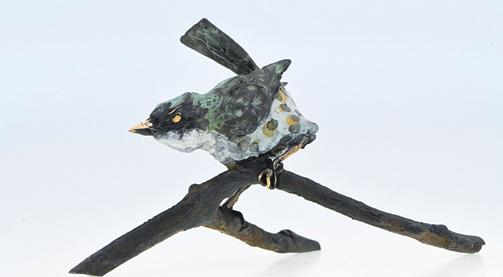
Bob Dylan is infamously quoted as having said that, “no one is free, even the birds are chained to the sky”. Melancholic as the sentiment might be, this is a reality that manifests far too quickly in many of us, without its presence even being realized. If left unchecked, the four corners of our lives will creep steadily inward and ensnare us in a daze of the mundane – even absolute freedom, as it were, when taken for granted, can become one’s cage.
It is left to those individuals on the fringe, the artist – that oracle of emotion and maverick of expression – to keep pursuing acts of creative defiance, and to keep pushing the sky away. It is through the medium of art that we are able, but for a moment, to take flight – to escape and transcend the boundaries of our every-day perception. Art therefore has the ability to elicit within us a sensation akin to tangible flight – a supernatural feeling of weightlessness, and an out-of-body insight into what otherwise passes us by in a commonplace stupor. It is in this vein that IS Sculpture, in another celebrated collaboration with the Tokara Wine Estate, has postulated a summer exhibition, titled Birds, comprised of artists that defy the boundaries of what seeks to encage our perception. With vigour and ardour, whether in the study of the raw emotion that underlies artistic expression or the medium of expression itself, these artists weave epic narratives of our innermost struggle – absolute freedom cast against a self-created immure.
Birds includes artists such as Sarel Petrus, who needs no introduction for his intimate engagement with the avian form. Sarel creates work that resonate with a deafening tone the often sinister dance of our most cavernous emotions, which, when left to their own liberties, may come to define us. His sculptures are seared with indistinct impression of loveletters and tales of a romance otherwise forlorn, forgotten and shunned from the light. His works are burnished with the remnants of a love that has taken flight – perhaps for good, or perhaps for bad.

Sarel Petrus, Crossing 4
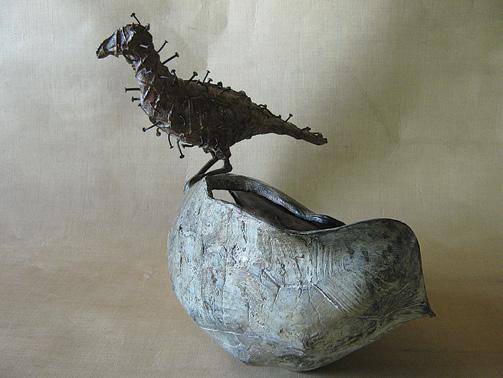

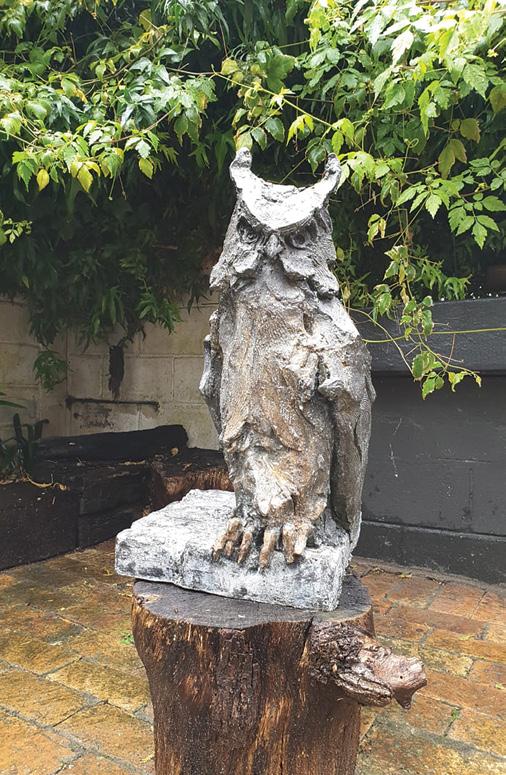
Alastair Barnes, Peregrine Falcon.

Other staples from the IS Art Sculpture repertoire include Kobus le Grange’s prolific wood-sculpture, which has in and of itself become known for its defiance of form and neo-traditional allure. Wilma Cruise, Isabel Mertz and Marieke Prinsloo-Rowe are also featured as sculptors who elicit a whimsical and often nostalgic portrayal of playful emotions that transcend singularity and cut to the heart of our inner-child – where the fastidious observance of reality have not yet manifested. The exhibition further features the works of Alastair Barnes, Roberto Vaccaro and Johan Theron to name a few. Birds is a collection of sculpture that praise the liberation of emotion that art brings to the onlooker, and the artists’ role milling our perception and articulating the unidentifiable fragments of our being.
The exhibition will run from 6 December 2020 to 31 March 2021 at the Tokara Wine Estate. For more information contact: gallery@isart.co.za / tel: (021) 883 9717 IS Art Gallery 29 Church Street, Stellenbosch, WC IS Sculpture Tokara Wine Estate, Helshoogte Road, Stellenbosch, WC
Business Art News STEPHAN WELZ & CO.
www.swelco.co.za
Walter Whall Battiss (South African 1906 - 1982), Picking Flowers, R 200 000 - R 300 000. Opposite Page: Norman Clive Catherine (South African 1949 - ), Cogitator, R 300 000 - R 400 000
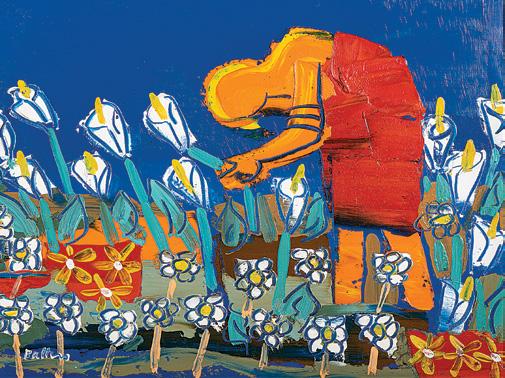
2020 will go down in history as one of the most memorable years, filled with stories of survival, not just in terms of the Covid19 pandemic, but the economic fallout that followed. Stephan Welz & Co. wasn’t immune to the stresses of 2020, but has managed to come out the other end with a renewed energy and an exciting approach to auctions moving forward.
It has been a delight to watch the resilience of the art market throughout this year, and we are enjoying a general move towards embracing digital platforms and allowing them to become a more accepted form of art practice. While the digital realm has been a part of the auction world for a while, it is now becoming a core aspect of the way Stephan Welz & Co. is presenting South Africa’s art to the world. Our specialists have also had a year of ups and downs, and have made a huge effort to ensure that the highlights of the year in terms of art offerings weren’t overshadowed by a global pandemic, which was hanging over everyone’s heads. Luke Crossley and Suzanne Duncan, heads of their respective Fine Art departments in Cape Town and Johannesburg, have shared their highlights from 2020 below.
Suzanne Duncan, Cape Town:
“It has been a very tumultuous year to say the very least, with trends in the auction world seemingly changing from month to month. One of my highlights of this unusual year was witnessing our team pulling together to ensure that we held our auctions regularly and that our offering of items across all of our departments remained strong.
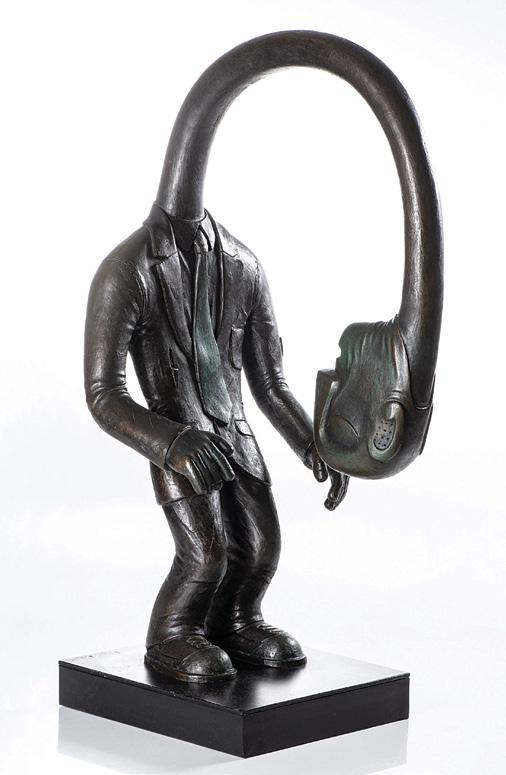
One of the aspects that I am personally very proud to have been involved with is the inclusion of a number of artworks by the German expressionist A.R Penck, throughout all of our Cape Town based auctions in 2020. Penck witnessed a long career, beginning in East Germany, where influential allies saw potential in the artist and would assist him in smuggling his work into the west. The artist passed away in 2017 and since then the demand for his work on the auction market, coinciding with a number of retrospective exhibitions, has increased.

The works we have offered by this artist have included early drawings where the artist was still using his given name Ralf Winkler, before he changed to a variety of synonyms to confuse the East German police; as well as collaborative, mixed media works produced at a time where he was part of the artist’s collective Lücke TPT. Penck also uses an interesting technique where he screenprints the same image onto a number of canvases (which he does not edition) and then paints over each work, so that no two works in the series are alike. Our most recent example of this technique sold on our October Auction for R 638 550. The majority of our A.R Penck artworks boast Galerie Frank Hänel as their original provenance. I feel privileged to have consigned and sold so many A.R Penck artworks this year, especially as we are the only auction house in South Africa to offer the work of this fascinating artist.
A list of art highlights for 2020 would not be complete without mentioning the work Norwegian Landscape by Edvard Munch which we offered in our August Auction. The highly sensitive etching was the first artwork created by the artist after his nervous breakdown in 1908 and is a testament to the courage of a soul in a state completely undone yet still compelled to create and record their experience. We believe that this print was the first work by the artist to be offered by an auction house in South Africa”.
Luke Crossley, Johannesburg:
“There are a few things that stand out as highlights for me this year. It was really special to handle a collection of early editions by John Muafangejo that were offered on our April sale. It is always a pleasure to handle works by the artist that are still in their original full sheet size and have been so well preserved, and were accompanied with a wonderful provenance. Through the process of working with these prints, we were able to explore more about the artist’s history and present collectors with an in-depth contextualisation for a perhaps slightly neglected artist.
Andy Warhol Vesuvius, which was offered on our most recent Johannesburg sale, was certainly one of the highlights of the year. It’s not everyday that we, as art specialists, get to handle a work by such an internationally renowned artist. It was fantastic to see the layering of techniques, textures and colours when examining the piece outside of its frame, and it was even more exciting to see the work’s successful sale on auction. We were also lucky enough to handle a wonderful Skotnes work on the same sale. This was a truly awe-inspiring piece, still housed in the artist’s original carved frame, and featured a wonderful combination of painting and carving. The size of this piece alone made it a spectacular addition to our list of highlights.
Working with the Salvador Dali pieces throughout the year has also been most memorable— the history and technique behind the works illustrating Dante’s “Divine Comedy” has been fascinating, particularly in terms of the history origination and execution of this mammoth project. It has been a pleasure to handle these works this year and more so, watch the art market adapt to a new art world”.
We are still eagerly awaiting our final sale of 2020, which will be beginning on the 7th December, and we are excited to see many wonderful pieces go under the hammer. We are hoping for a successful sale with highlights including a charcoal drawing by William Kentridge, multiple sculptures by Norman Catherine and an eye-catching oil work by Walter Battiss. We are confident that our final sale of the year will reflect our unwavering art market and loyal client base and that we will end this topsy-turvy year on a high.
Edoardo Villa (South African 1915 - 2011), Abstract, R 150 000 - R 200 000. Opposite Page: William Joseph Kentridge (South African 1955 - ), Poggio Al Topo + Liviol House May 1993, R 300 000 - R 500 000

Business Art News STRAUSS & CO Strauss & Co’s NORTH/SOUTH sale topped by Irma Stern, but new trends emerge
www.straussart.co.za
Private and institutional bidders from over 20 countries on five continents participated in Strauss & Co’s first-ever dual-city marquee sale, NORTH/SOUTH, which concluded on 11 November with sales totalling R98,9 million from 633 lots sold achieving a 72% sell-through rate and three new world records. Held concurrently in two locations, Cape Town and Johannesburg, the multi-day sale attracted a mix of online, telephone and in-person bidders drawn by the firstrate consignment of collectable art, fine wines, decorative arts and jewellery.
Auction bellwethers J.H. Pierneef, Alexis Preller and Irma Stern performed reliably well, as did lots by William Kentridge, Sydney Kumalo, Stanley Pinker, Penny Siopis and Jean Welz. But the sale also saw strong performances by contemporary painters such as Phillemon Hlungwani, Simphiwe Ndzube, Mustafa Maluka (achieved a new world record) and Bambo Sibiya, pointing to the emergence of new collectors in the secondary market.
Frank Kilbourn, Strauss & Co chairperson commented after the sale: “NORTH/ SOUTH was conceived in response to the extraordinary times of 2020, when new hybrid ways of doing business have become the norm. The programming of this ambitious sale included sessions introducing new artists and new media, as well as sessions presenting innovative approaches to showcasing our offering. A quarter of our lots went to new buyers, which is very impressive and meaningful. The fact that so many of the more expensive works on offer went to new and/or less well-known clients is also a positive takeout from this sale, which was held in difficult economic circumstances. Our results point to a renewal among collectors, but also continuity in the age-old tradition of collecting.”
Irma Stern, Still Life of Dahlias in a Vase with a Basket of Apples, oil on canvas 55 by 50cm, SOLD R 3 983 000

Irma Stern scored well in the tally of top lots, with three of the highest-earning lots in NORTH/SOUTH produced by this acclaimed expressionist painter. Well known for her still lifes, two top works in this genre – painted in 1937 and 1945 – earned just short of R4 million each. Still Life of Dahlias in a Vase with a Basket of Apples was consigned by the Tasso Foundation Collection of important South African art assembled by the late Giulio Bertrand of Morgenster, as was Stern’s 1927 portrait of a Swazi woman, which sold for R2.8 million.
Other highlights from the Tasso Collection included Stanley Pinker’s sensuous figure painting The Bathers, sold for R1 million; Alexis Preller’s tropically themed The Red Pineapples, sold for R1.25 million; William Kentridge’s composite drawing Tree, sold for R1.1 million; and Zimbabwean sculptor Tapfuma Gutsa’s stone piece Birth of the Zambezi, sold for R193 460. Several impressive works from private single-owner collections went under the hammer in NORTH/
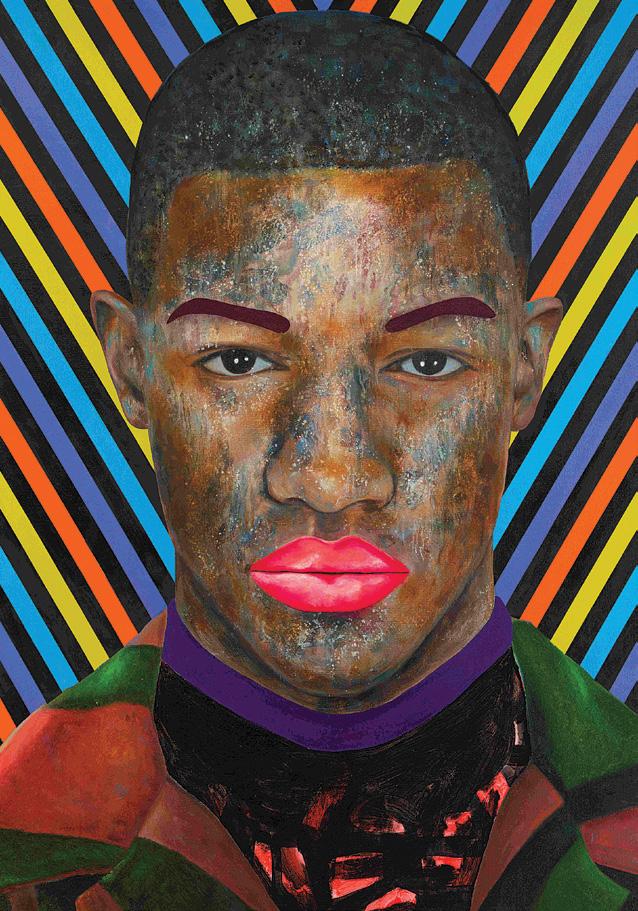
Previous Page: Mustafa Maluka, Right You Are (If You Think You Are), acrylic and oil on canvas 184 by 133,5cm, SOLD R 569 000. Above: Jacob Hendrik Pierneef, Kaap Bloubergstrand, oil on artist’s board 43,5 by 58,5cm, SOLD R 2 617 400. Opposite Page: Alexis Preller, Thrones of Heaven, oil and gesso on canvas 101,5 by 86,5cm, SOLD R 2 845 000
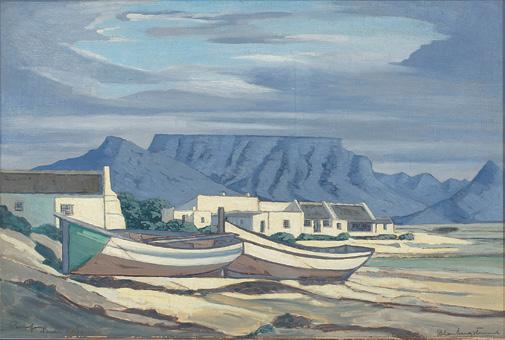
SOUTH, including Sydney Kumalo’s Madala I, a special highpoint of South African modernist sculpture, consigned by the Late Desmond Fisher Collection and sold for R1.82 million achieving a new world record for the artist.
J.H. Pierneef and Alexis Preller drew consistently strong bids. Three telephone bidders vied for Preller’s late-period abstraction Thrones of Heaven, but were ultimately beaten by an online bidder who entered the fray at the last minute and clinched the work for R2.8 million. NORTH/SOUTH witnessed vigorous bidding throughout for Pierneef, with a 1934 Cape marine landscape of Bloubergstrand emerging as the top piece, fetching R2.6 million.
NORTH/SOUTH commenced on 8 November with a session devoted to fine wine. The offering comprised a superb collection of 19 iconic domaines from Burgundy and the Rhône – including the likes of Domaine Armand Rousseau, Domaine Comte Georges de Vogue and Domaine de la Romanee-Conti – all consigned by a single private owner. A definite highlight was the single bottle of 2015 Echezeaux from hallowed producer Domaine de la Romanee-Conti, which sold for R51 210.
“Being well aware of a small captive market for these highly niche wines locally, we are very satisfied with having achieved a sell-through rate of above 80% with this unique and ground-breaking sale,” says sommelier Higgo Jacobs, who initiated the fine-wine sale with Roland Peens of Wine Cellar in partnership with Strauss & Co.
NORTH/SOUTH featured a number of formal innovations, including a special focus on contemporary South African ceramics. One of the highlights of the busy New Collector session was John Newdigate and Ian Garrett’s Birds Feeding, a large and colour-rich porcelain vessel decorated with animal motifs, which went to a Cape Town telephone bidder for R182 080 after a flurry of bids.
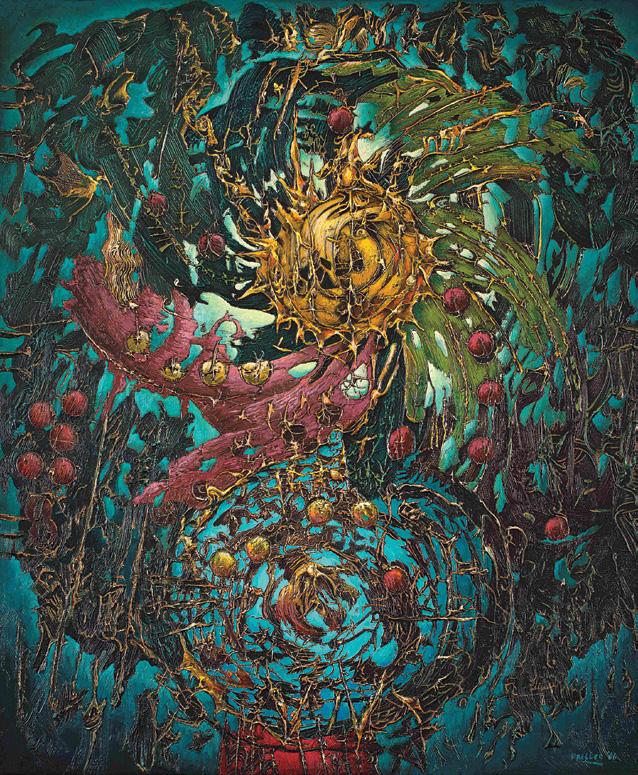
The ceramics session saw healthy prices paid for important pieces by Hylton Nel, including a generous R73 970 for his glazed earthenware piece Flower Cat. Two green-glazed hares by Nico Masemola, a former apprentice of Nel, sold for R62 590. Masemola’s output was cut short by his premature death in 2015 and is now highly sought after.
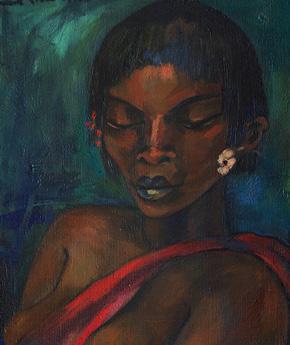
Strauss & Co senior art specialist Wilhelm van Rensburg spearheaded this wide-ranging showcase of ceramics. The offerings included lots by established figures like Esias Bosch and Bonakele Ntshalintshali, as well as rare pieces by artists Deborah Bell, Robert Hodgins, William Kentridge and Hannatjie van der Wat. “The sale confirmed the reputation of pioneers like Noria Mabasa and Nesta Nala and contemporaries like Ruan Hoffmann and Ian Garrett, whose work skilfully reinterprets indigenous stoneware techniques,” says Van Rensburg.
Susie Goodman, an executive director at Strauss & Co says: “The Strauss & Co team really pulled out all the stops to put together a representative showcase of ceramics by a wide range of ceramicists active over the last half century. At one point during the ceramics sale we had 673 active bidders. They included private individuals as well as reputable institutions, which is a fantastic endorsement of the quality of our offering.” Another important innovation was Interiors, a session featuring a curated selection of Cape, English and European furniture and collectable silverware interspersed with fine examples of 20th-century South African painting. Under the experienced eye of Vanessa Philips, Strauss & Co’s joint managing director, the session aimed to highlight the total experience of collecting. A highlight from the furniture offering was a remarkable walnut pipe cabinet by Alfred Dunhill, which fetched R477 960. The sale also included two rare René Lalique ‘Source de la Fontaine’ glass figures which sold for R341 400 each.
Among the highlights of the art offering in the Interiors session were Anton van Wouw’s Massa foundry bronze Dagga Smoker, which sold for R1 million, and a trial proof of William Kentridge’s hand-coloured etching Dutch Iris, which achieved R1.25 million. An enigmatic still life depicting brilliant red pelargoniums by J.H. Pierneef drew considerable attention. Being the only known example of a still life with flowers by this acclaimed landscape painter, the work attracted a number of bidders and was sold for R796 600.
The Interiors session was preceded by a session featuring jewellery and oriental works of art. A necklace composed of a series of graduated pear-shaped diamonds sold for R1.1 million. Interest in historical Chinese objets remains strong: a pale celadon jade snuff bottle from the Qing dynasty sold for R54 624.
Frank Kilbourn says: “I was encouraged by the enthusiastic response to our new ceramics and interiors sessions, both of which were new innovations and formed part of our broader mission at Strauss & Co to
cultivate new collectors and introduce new ideas. It is no secret that it is currently a buyer’s market, but this sale showed that there will always be appetite for first-rate collectables, whatever the economic situation.”
Irma Stern, Swazi Woman, oil on canvas laid down on board 51,5 by 39cm, SOLD R 2 845 000
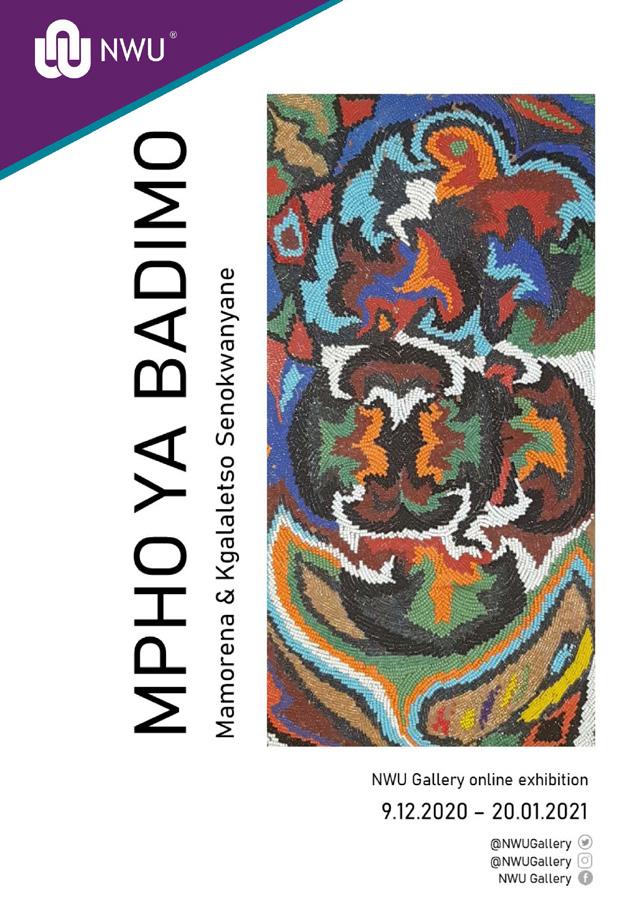
A Good Read PASTURES NEW Why some top gallery staff are moving on from longtime jobs
Published in The Art Newspaper 19th November 2020 By Melanie Gerlis
Personal Gmail accounts have been reactivated as some experienced gallery staff are either unexpectedly looking for work or seizing the (pandemic) day to try something new. Among the latter, recent senior level departures include Gary Waterston, at Gagosian gallery for 18 years and latterly as its managing director for Europe; Graham Steele, a partner at Hauser & Wirth and a force in its Los Angeles gallery; and Lock Kresler, a senior director at Lévy Gorvy and at the helm of its London outpost.
The circumstances of each departure are of course different, but uniting this trio is a sense that the introspection and out-of-office time afforded by the Covid-19 pandemic have forced a rethink. Kresler, who started at Lévy Gorvy in 2014, and just a week before his first child was born, feels that the London gallery has grown into a “more self-sufficient and larger operation” and that working from home distilled the need to strike a different balance. “Now I have two kids and want more flexibility,” he says—though he and Waterston are keeping their next moves close to their chests.
The chances are—as with Steele, who is starting a new private dealership—that neither is going to another traditional gallery role. The industry’s already-strained needs changed overnight once lockdowns struck. While in the Before Time, galleries needed as many staff as possible—to juggle art fairs, multiple installs and plenty of client entertainment—these aren’t coming back soon. Neither, on reflection, do they add up to a well-balanced life.
What hasn’t changed is a broad appetite for art. “The growth that everybody became so comfortable with will just manifest itself differently,” says Waterston. He compares the art market favourably with more challenged industries such as hospitality.
It is optimistic, but there’s comfort to take from this right now. Just as after the last economic crisis, out of which the art adviser industry seemed to grow, an entrepreneurial spirit is emerging from the Covid crisis. Graham Southern, who left Blain Southern last year (before the gallery he co-founded went into administration and shut down), has started an artist management business, a relatively untapped area that many think will grow more. “I didn’t predict the pandemic, but this seems even more relevant since,” Southern says. Digital advances will also not disappear in the After Time and will create opportunities for those who can harness and adapt them best.
The latest Art Basel & UBS Art Market Report found that, on average, a third of the 795 galleries surveyed cut their staff in the first six months of 2020. Separate research by UBS’s Global Wealth team has also found a surge in new business formation in major economies around the world, including in the US, where business registrations are up 14% compared to the same period last year. This, the bank finds, is not just about finding something to do, but represents a gauge of economic confidence.
We’ve been thrown a curve ball, and not every new idea is going to fly. But crises disrupt industries, throw out accepted norms to make way for new, entrepreneurial models— particularly when married with long experience. Right now, fortune favours the brave.

A Good Read MARY WOLLSTONECRAFT People see only ‘silver tits’ and ‘bouffant pubes’ now—but I predict Mary Wollstonecraft sculpture will become widely admired.
Published in The Art Newspaper 17th November 2020
One of the iron rules of art history is that the more derided a work of art when first exhibited, the more celebrated it will become. They laughed at Monet’s Impression, Sunrise (1872) when it was first shown, and the term “impressionist” was originally intended as an insult. But even Monet might have struggled to cope with the fury unleashed on Maggi Hambling for her Sculpture for Mary Wollstonecraft.
On paper, a statue of “the mother of feminism” by one of Britain’s leading female artists must have seemed a guaranteed success. But rarely has a statue been so criticised at its unveiling. The amorphous base surmounted by an idealised female nude was too complex for today’s world of instant judgement. People saw only “silver tits” and “bouffant pubes”. Criticism ranged from the obvious—“it doesn’t look like Wollstonecraft”—to the affronted: “you never see Charles Dickens with his balls out, do you?”
However, I wouldn’t write it off yet. These days even backlashes get a backlash, and more are now seeing the statue’s merits. If Sculpture for Mary Wollstonecraft does become more widely admired, then I claim my place among those who declared that “actually, they always quite liked it”. Certainly, the silvery colour takes getting used to—it looks as if Goldfinger has been experimenting with cheaper ways to kill— but a few years of London pollution will help it acquire some much-needed patina.
The furore over the statue’s nudity took me by surprise. Clothes rarely work on a statue; it’s why the ancients preferred their marbles naked, or clad only in the simplicity of a toga. A statue of Charles Dickens with his balls out—and we can deduce from his ten children that they often were—would have much to admire. Nor is nudity in British public sculpture new; the first nude public statue in Britain, Achilles, was erected in Hyde Park in 1822 (it was paid for by the “Ladies of England”, who evidently had no qualms about the nudity, although after some debate they did vote for a fig leaf).
What I like about Hambling’s figure is that it is nude, but not erotic. Wollstonecraft would have recognised the honesty of Hambling’s focus. “For man and woman,” she wrote in The Vindications of the Rights of Women (1792), “truth… must be the same; yet the fanciful female character, so prettily drawn by poets and novelists, demanding the sacrifice of truth and sincerity, virtue becomes a relative idea, having no other foundation than utility, and of that utility men pretend arbitrarily to judge, shaping it to their own convenience.” Naked, stripped of outward signs of wealth and privilege, we are all equal.
If 2020 has taught us anything about statues, it is that a statue is now about much more than just itself. What matters is the context and controversy it creates. The age of statues as commemorations of Dead Historical Personage staring into the distance, ignored by all who walk past it, is over. Today’s statues must be works of performance art, able to pierce the boundary between the physical space and the digital. It is because Sculpture for Mary Wollstonecraft is so eccentric that more people are talking about Wollstonecraft than at any time since the 19th century. For the group who commissioned the statue, Mary on the Green, it is £143,000 well spent. We will have to wait and see if art history comes to the same conclusion.
